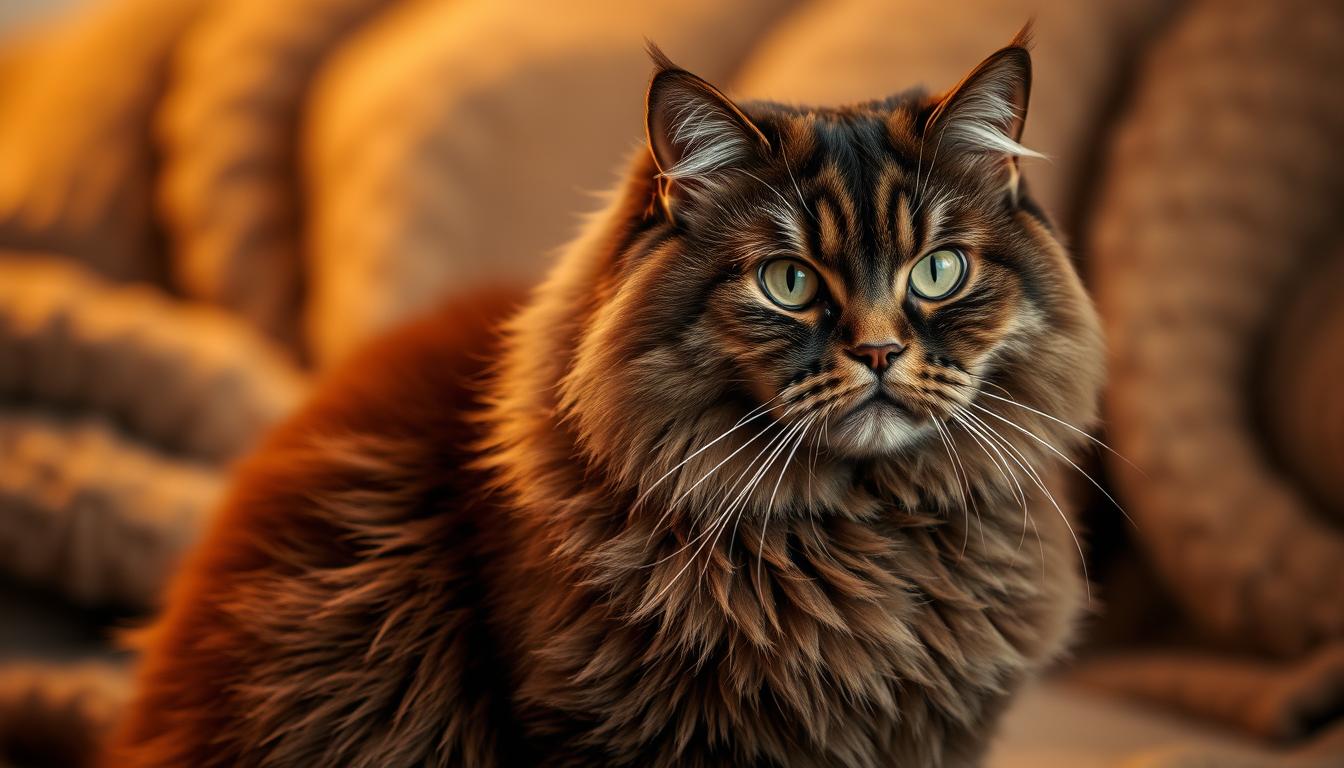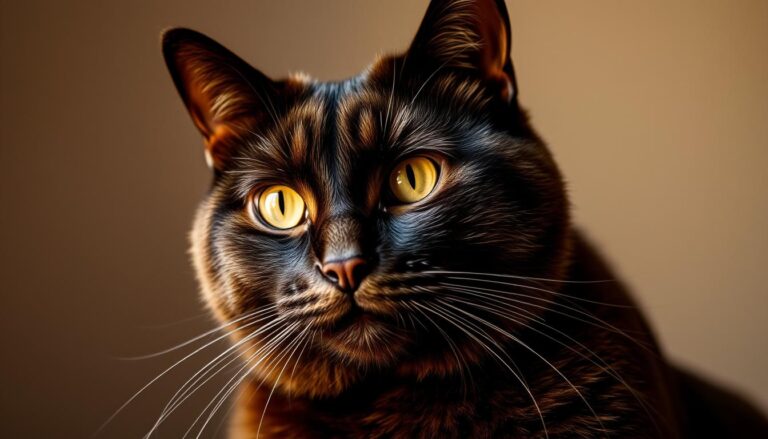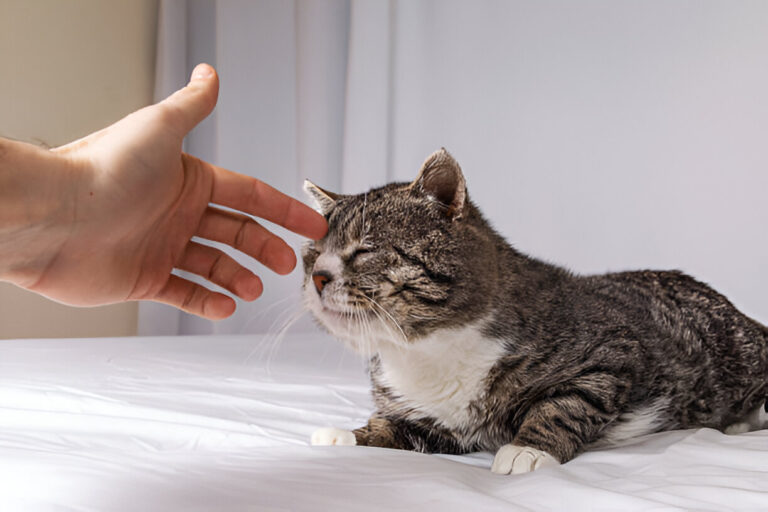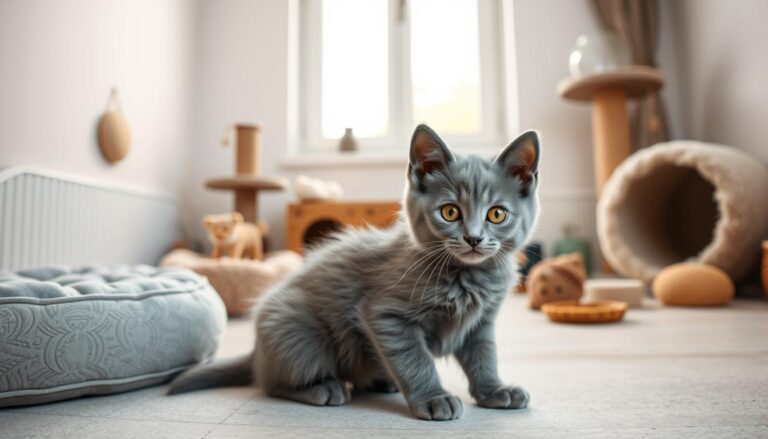What Makes the Brown British Shorthair Unique?
Table of Contents
When I first saw a brown British Shorthair cat, it was like finding a hidden treasure. These cats win hearts with their special looks and fun personalities. They are truly different from other breeds.
The brown British Shorthair is a beautiful color of the British Shorthair cat breed. They have soft fur and round faces that show their playful side. Their unique look and strong build make them a favorite among cat lovers.
As a pet, the brown British Shorthair is special. They are gentle and have a beautiful appearance. They are great for families, singles, and anyone who loves cats. They make wonderful, loyal, and easy-to-care-for friends.
Key Takeaways
- Distinctive brown coloration makes these cats truly unique
- British Shorthair breed known for exceptional temperament
- Robust and adaptable to various living environments
- Plush coat requires minimal grooming
- Excellent companion for different types of households
Introduction to the Brown British Shorthair Breed
The brown British Shorthair cat is a standout among feline lovers. It comes from the classic British Shorthair cat family. This color variant adds a special charm to the breed. These cats are known for their sturdy build, soft coats, and engaging personalities.
Exploring the brown British Shorthair breed reveals a cat that’s both elegant and strong. Their brown coat can range from light chocolate to deep mahogany. This makes them stand out among other cats. The breed is also known for its friendly nature and sturdy build, with the brown version adding to their beauty.
- Distinctive brown coat coloration
- Robust and muscular body structure
- Gentle and adaptable temperament
- Recognized for their round faces and plush fur
“The brown British Shorthair is not just a cat, but a living work of art with its stunning coat and charming personality.” – Feline Breed Experts
Cat enthusiasts are drawn to the brown British Shorthair for its beauty and personality. These cats fit well into family life. They offer both playfulness and calmness.
| Breed Characteristic | Description |
|---|---|
| Coat Color | Various shades of brown, from light to deep chocolate |
| Temperament | Calm, friendly, and adaptable |
| Origin | United Kingdom |
| Size | Medium to large |
Whether you’re a seasoned cat owner or considering your first feline friend, the brown British Shorthair offers a perfect blend of beauty, personality, and companionship.
The Distinct Physical Characteristics of Brown British Shorthairs
The brown British Shorthair is a standout cat breed. They have stunning looks that win over many cat lovers. Their mix of strength, elegance, and charm makes them unique.
Coat Color Variations and Patterns
Brown British Shorthairs come in a wide range of colors and patterns. Their coats can be deep chocolate or warm tawny, making them look rich and vibrant. They often have:
- Solid brown coats with uniform coloration
- Chocolate brown with subtle shading
- Lighter caramel-like brown tones
Body Structure and Size
The physical build of a brown British Shorthair is impressive. They have a strong and muscular body. This shows their solid genetic background.
| Characteristic | Details |
|---|---|
| Weight Range | 8-16 pounds |
| Height | 10-12 inches |
| Body Type | Compact and muscular |
Facial Features and Expression
The faces of brown British Shorthairs are truly captivating. They have a teddy bear-like appearance with round faces and large copper or gold eyes. Their short, broad nose adds to their cute look.
Their round cheeks and short, dense fur make them look cuddly. This makes them one of the most attractive cat breeds for many.
Historical Origins and Development of the Breed
The british shorthair cat has its roots in ancient Rome. These cats were brought to Britain during the Roman conquest. They quickly adapted to the British landscape, developing unique traits.
In the late 19th century, cat lovers started documenting and breeding the brown british shorthair. This color variant showed the power of selective breeding and understanding feline coat colors.
Key Milestones in Breed Development
- 1870s: First organized breeding efforts begin
- 1887: First british shorthair cat recognized by cat registries
- Early 1900s: Breed faces significant challenges during World Wars
- 1950s: Breed revival and standardization efforts intensify
World Wars I and II were tough times for the breed. Many breeding programs were stopped, and the cat population fell. But, dedicated breeders worked hard to save and rebuild the breed’s genetic diversity.
| Period | Breed Status | Key Developments |
|---|---|---|
| 1870-1900 | Early Establishment | Initial breed recognition |
| 1900-1945 | Survival Challenge | Population decline during World Wars |
| 1950-1980 | Breed Restoration | Genetic diversification and breed standard refinement |
The brown british shorthair breed is a special color variant. It’s known for its unique look and strong genetic background. Today, breeding practices keep the breed’s traits while ensuring genetic health.
Understanding Brown British Shorthair Temperament
The brown British Shorthair is a wonderful pet with a special personality. They are calm and affectionate, making them loved by many.
These cats are perfect because they balance being independent and loving. They don’t need too much attention, which is great for any home.
Social Behavior with Humans
Brown British Shorthairs are great with people because of their unique traits:
- Calm and composed demeanor
- Gentle and patient with family members
- Quiet and non-intrusive companionship
- Preference for peaceful interactions
“A brown British Shorthair doesn’t demand constant attention but provides subtle, loving companionship.” – Feline Breed Experts
Interaction with Other Pets
They get along well with other animals. Brown British Shorthairs are usually:
- Maintain a relaxed attitude toward other animals
- Avoid aggressive behaviors
- Coexist peacefully in multi-pet households
Adaptability to Different Environments
These cats are very flexible in different homes. They fit well in both small and big places, keeping their calm nature.
They are easy-going, making them great friends for those who want a calm pet.
Essential Care Requirements for Your Brown British Shorthair
Caring for a brown British Shorthair cat needs focus and knowing their special needs. These cats are easy-going but need regular care to stay healthy and happy.
For your brown British Shorthair to do well, plan a good care routine. Start by making a cozy indoor space that fits their needs:
- Provide a quiet, stable living space
- Ensure access to clean water and nutritious food
- Create designated resting and play areas
- Maintain a consistent temperature
Regular vet visits are key for your British Shorthair’s health. Schedule yearly check-ups to spot health issues early and keep your pet in top shape.
Here are the must-haves for your brown British Shorthair:
- High-quality litter box
- Scratching posts
- Interactive toys
- Comfortable bedding
- Grooming tools
Mental stimulation is crucial for your British Shorthair cat. These smart cats need fun activities to avoid boredom and stay well. Spend time playing and enriching their environment to keep them joyful and healthy.
Good care for your brown British Shorthair means knowing their personality and creating a supportive home. This will meet their physical and emotional needs.
Health Considerations and Common Medical Issues
Caring for a brown British shorthair cat means knowing their health needs. These cats have special health concerns that every owner should be aware of.
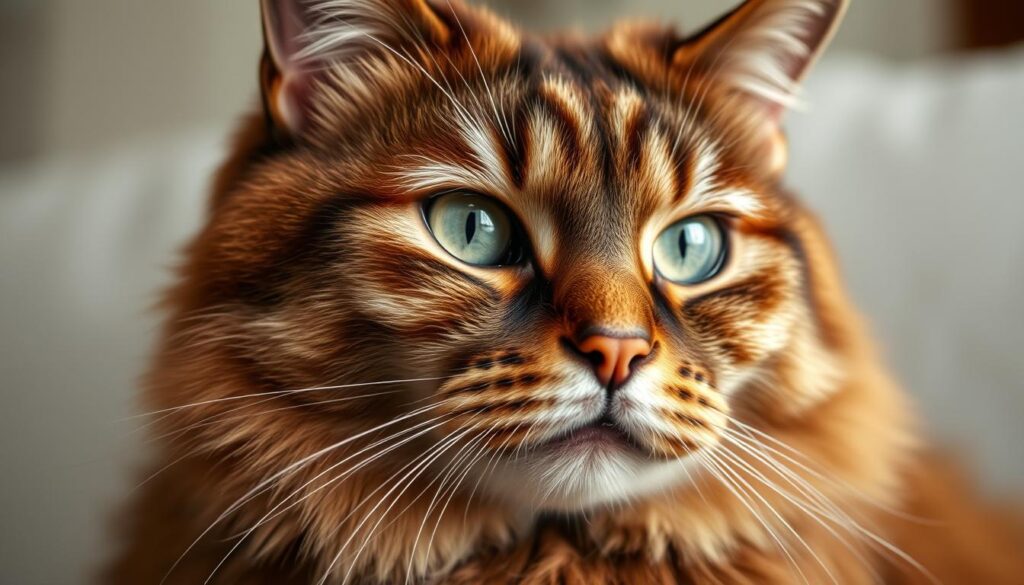
Genetic health issues are important for brown British shorthairs. Good breeding practices help avoid these problems.
Common Genetic Health Concerns
- Hypertrophic cardiomyopathy (heart muscle disease)
- Polycystic kidney disease
- Hereditary eye conditions
- Joint and bone disorders
Preventive Care Strategies
Keeping your British shorthair healthy is key. Regular vet visits can catch problems early.
| Age Group | Recommended Screenings | Frequency |
|---|---|---|
| Kitten (0-1 year) | Initial vaccinations, genetic screening | Every 3-4 months |
| Adult (1-7 years) | Annual physical, dental check | Yearly |
| Senior (8+ years) | Comprehensive health panel | Twice yearly |
Lifespan and Aging Factors
Your brown British shorthair can live 12-17 years. Good food, exercise, and vet care help them live longer.
“Prevention is always better than cure when it comes to your feline friend’s health.” – Veterinary Wellness Magazine
Watch your cat’s weight, feed them right, and keep them calm. This helps them stay healthy and live longer.
Grooming and Maintenance Tips
Caring for your brown coat British Shorthair is important. They have a dense, plush coat that needs regular grooming. This keeps their fur rich brown and prevents matting.
Your grooming routine should cover a few key areas:
- Brush your cat 2-3 times a week
- Use a metal comb or soft-bristled brush to remove loose hair
- Pay extra attention during seasonal shedding periods
Bathing is rare for these cats, as they groom themselves well. When bathing is needed, use a cat-specific shampoo. This keeps their natural oils in their coat.
Other grooming tips include:
- Nail trimming every 2-3 weeks
- Regular ear cleaning to prevent wax buildup
- Dental care through weekly teeth brushing
Special care for your brown British Shorthair’s coat keeps it looking beautiful. Regular grooming also strengthens your bond. It lets you check for any unusual skin conditions.
Pro tip: Regular grooming sessions are an excellent opportunity to check your cat’s overall health and detect any potential issues early.
Dietary Needs and Nutrition Guidelines
Proper nutrition is key for your brown British Shorthair cat’s health and energy. Knowing their special dietary needs helps you care for them well.
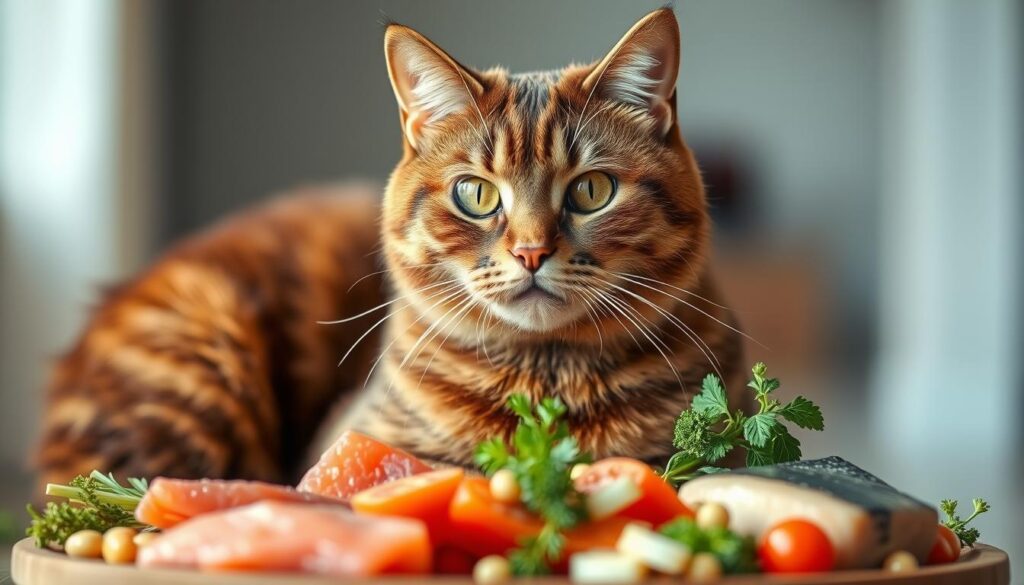
Nutrition is vital for brown British shorthairs. It affects their overall health. These cats need certain foods that other breeds don’t.
Recommended Food Types
- High-quality protein-rich wet food
- Premium dry kibble for adult cats
- Grain-free options with real meat first
- Special British Shorthair cat food blends
Feeding Schedule and Portions
| Age Group | Daily Portions | Feeding Frequency |
|---|---|---|
| Kittens | 1/4 to 1/2 cup | 3-4 times daily |
| Adult Cats | 1/2 to 3/4 cup | 2 times daily |
| Senior Cats | 1/3 to 1/2 cup | 2 times daily |
Special Dietary Considerations
British Shorthairs can easily get too fat. It’s important to watch their weight. Your vet can make a diet plan just for them.
- Limit treats to 10% of daily calories
- Always have fresh water available
- Consider their age when choosing food
- Look out for food allergies
Good nutrition is crucial for brown British shorthairs. Choose quality foods and stick to a regular feeding schedule. This will keep your cat healthy and happy.
Exercise Needs and Environmental Enrichment
The brown British Shorthair cat might seem laid-back, but they still need regular exercise. They enjoy activities that keep them healthy and entertained. These cats are not hyperactive, but they love to play.
Creating a rich environment is key for your British Shorthair cat. These smart cats need interactive play and mental challenges. This keeps them from getting bored and keeps them well.
- Interactive toys that mimic hunting behaviors
- Puzzle feeders to stimulate mental engagement
- Climbing trees and scratching posts
- Short play sessions throughout the day
For your brown British Shorthair, aim for 10-15 minutes of play two to three times a day. Use wand toys, laser pointers, and small balls to keep them interested. These activities help keep their muscles toned and prevent weight gain.
Indoor enrichment is very important for British Shorthair cats. Set up perches near windows and create vertical spaces. Also, rotate toys to keep things interesting. Your cat will love these chances to stay mentally and physically active.
Remember, a stimulated cat is a happy and healthy cat!
Think about getting cat trees, window seats, and interactive electronic toys. These toys challenge their natural hunting instincts. They help prevent them from being too sedentary and keep them well.
Selecting and Adopting a Brown British Shorthair
Getting a brown British Shorthair is an exciting adventure. It’s important to choose carefully to find the right cat for you.
Looking for brown British Shorthair kittens requires a thoughtful approach. It’s about finding a cat that fits your life and what you want.
Finding Reputable Breeders
Finding a good breeder is key when searching for a brown British Shorthair. Look for these important things:
- Transparent health screening documentation
- Clean, spacious breeding environment
- Willingness to answer detailed questions
- Registered with recognized cat breeding associations
Cost Considerations
The price of brown British Shorthair kittens can vary. Several factors affect the cost:
| Category | Estimated Cost Range |
|---|---|
| Kitten Price | $800 – $2,500 |
| Initial Veterinary Expenses | $200 – $500 |
| Annual Maintenance | $500 – $1,000 |
Adoption Preparation Checklist
- Prepare a dedicated cat space
- Purchase essential supplies
- Schedule initial veterinary examination
- Cat-proof your living environment
- Plan for gradual home integration
Tip: Always prioritize the cat’s health and compatibility with your home environment when selecting your new furry friend.
Conclusion
Choosing a brown British Shorthair cat is more than picking a pet. It’s welcoming a sophisticated friend into your home. These cats have elegant looks and a balanced personality. They fit well in many homes.
Having a brown British Shorthair cat means making a big commitment. You need to feed them right and take them to the vet regularly. This care ensures they stay healthy and happy.
Each brown British Shorthair has its own special traits. They are gentle and have beautiful looks. They can make any home special, whether it’s big or small.
Understanding their needs and appreciating their unique qualities will deepen your bond with them. They are loyal and charming. This makes for a rewarding relationship that goes beyond just being a pet.
FAQ
What makes the brown British Shorthair different from other color variants?
Are brown British Shorthairs good family pets?
How much grooming do brown British Shorthairs require?
What are the typical health concerns for brown British Shorthairs?
How much do brown British Shorthair kittens cost?
What makes the brown British Shorthair different from other color variants?
Are brown British Shorthairs good family pets?
How much grooming do brown British Shorthairs require?
What are the typical health concerns for brown British Shorthairs?
How much do brown British Shorthair kittens cost?
FAQ
What makes the brown British Shorthair different from other color variants?
The brown British Shorthair stands out with its warm coat colors. These range from light tawny to deep chocolate. They share the same round face and sturdy build as other British Shorthairs. But, their brown color gives them a unique look.
Are brown British Shorthairs good family pets?
Absolutely! These cats are known for being calm and adaptable. They are gentle and patient, making them great with kids. Their laid-back nature makes them perfect for families, singles, and seniors.
How much grooming do brown British Shorthairs require?
Brown British Shorthairs need low grooming. Brush them once or twice a week to keep their coat looking good. This also helps prevent hairballs.
What are the typical health concerns for brown British Shorthairs?
Brown British Shorthairs might face health issues like heart disease and kidney disease. Regular vet visits and a healthy diet can help manage these. Keeping them at a healthy weight is also important.
How much do brown British Shorthair kittens cost?
Prices vary based on pedigree and breeder reputation. Expect to pay
FAQ
What makes the brown British Shorthair different from other color variants?
The brown British Shorthair stands out with its warm coat colors. These range from light tawny to deep chocolate. They share the same round face and sturdy build as other British Shorthairs. But, their brown color gives them a unique look.
Are brown British Shorthairs good family pets?
Absolutely! These cats are known for being calm and adaptable. They are gentle and patient, making them great with kids. Their laid-back nature makes them perfect for families, singles, and seniors.
How much grooming do brown British Shorthairs require?
Brown British Shorthairs need low grooming. Brush them once or twice a week to keep their coat looking good. This also helps prevent hairballs.
What are the typical health concerns for brown British Shorthairs?
Brown British Shorthairs might face health issues like heart disease and kidney disease. Regular vet visits and a healthy diet can help manage these. Keeping them at a healthy weight is also important.
How much do brown British Shorthair kittens cost?
Prices vary based on pedigree and breeder reputation. Expect to pay $1,500 to $3,000 for a kitten. Show-quality cats or those with special lineage might cost more.
Do brown British Shorthairs get along with other pets?
Yes, they are social and get along well with other pets. They are not territorial, making them great for homes with multiple pets.
What is the typical lifespan of a brown British Shorthair?
They live 12 to 17 years with proper care. Some may live longer with great health care and a loving home.
Are brown British Shorthairs high-energy cats?
No, they have low to moderate energy. They enjoy play but don’t get too hyper. Short play sessions and toys keep them happy.
What type of diet is best for a brown British Shorthair?
They need a protein-rich diet. Choose cat foods with real meat and balanced nutrients. Avoid too many treats to keep them healthy.
Can brown British Shorthairs live in apartments?
Yes, they are great for apartments. They are calm, don’t need a lot of space, and are happy indoors with attention.
,500 to ,000 for a kitten. Show-quality cats or those with special lineage might cost more.
Do brown British Shorthairs get along with other pets?
Yes, they are social and get along well with other pets. They are not territorial, making them great for homes with multiple pets.
What is the typical lifespan of a brown British Shorthair?
They live 12 to 17 years with proper care. Some may live longer with great health care and a loving home.
Are brown British Shorthairs high-energy cats?
No, they have low to moderate energy. They enjoy play but don’t get too hyper. Short play sessions and toys keep them happy.
What type of diet is best for a brown British Shorthair?
They need a protein-rich diet. Choose cat foods with real meat and balanced nutrients. Avoid too many treats to keep them healthy.
Can brown British Shorthairs live in apartments?
Yes, they are great for apartments. They are calm, don’t need a lot of space, and are happy indoors with attention.

